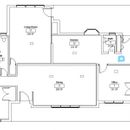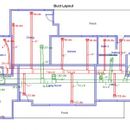Best Location for HVAC Supply and Returns
Zone 3A W/H – I have an existing oversized HVAC system that is due for replacement and have been looking to possibly convert the house to a rightsized 3 zone Mitsubishi ducted mini-split system, it’s a ranch-style house so it would be pretty easy to divide into thirds.
I’ve had a Manual J & S done, but I am concerned that the existing supply (shown in red) & returns (shown in blue) weren’t well thought out… master bedroom supply blows directly on the bed instead of towards windows or they blow directly on the ceiling fan, all the bedrooms (but bedroom 4) & office rely on door undercuts for their returns.
My main question though is how do you intelligently determine the optimal placement of supply and returns? It seems very subjective and from what I can tell there isn’t any software that handles it in the residential space.
I have had a clean sheet Manual D done on the house in Wrightsoft just to see what it potentially “should” have been, but I don’t really have any way to quantify the impact of leaving the house with the existing vent placement vs optimizing it.
Looks like Autodesk is kind of starting to move the direction of that functionality, but not sure it’s user friendly enough yet.
Thoughts?
GBA Detail Library
A collection of one thousand construction details organized by climate and house part












Replies
This is pretty good read for register sizing and placement.
https://www.priceindustries.com/content/uploads/assets/literature/engineering-guides/air-distribution-engineering-guide.pdf
Register locations are always a compromise between heating, cooling and occupant comfort. Generally you want both a high and low return and supply registers bellow windows in heating climates and above windows in cooling climates.
>"Generally you want both a high and low return and supply registers bellow windows in heating climates and above windows in cooling climates."
Placement in relatively close proximity to windows made sense in the day of air-leaky U1.0-1.5 windows in relatively cold climates (as in "not IECC zone 3A"). Even with IRC code-min replacement windows or low-E storms over clear-glass single panes that has much less impact on comfort, especially in locations with modest 99% outside design temps (such as most of zone 3A).
Milder climates can get a lot of sun through windows. Most houses are not designed with optimal orientation or shading in mind, thus it makes sense to put cooling near windows.
You can get good comfort with other register locations, my point was as general rule of thumb, you can't go wrong with putting them near windows.
P.S. Definitely in colder climates, but even with quality triple pane windows at home, I can feel those clear winter nights if I turn the floor heat off. Not cold, but not pleasant to sit near. Having a bit of extra heat there really makes the place significantly more comfortable.
>"Milder climates can get a lot of sun through windows."
But unless the window extends to the floor the warm spot taking the solar gain (reduced by more than half by a low-E coating) is happening several feet to the interior, not at the window. This is different from the cascade of cold air convecting down the window in a heating dominated climate pooling a the floor directly below the window creating a tightly localized cold spot. With solar gain it's not a tightly localized hot spot- the warmed zone is distributed somewhere in the interior of the room, sometimes close to but not directly at the window.
>"... my point was as general rule of thumb, you can't go wrong with putting them near windows."
Point taken- a long known well understood "truth".
My counter point was that one needn't create pretzel shaped duct sculptures or saw through structural timbers just to throw the heat/coolth at the windows in a house in zone 3A with decent (or at least code-min) window performance. In that climate zone outdoor temperatures rarely dwell below 0C or above 40C for very many hours at a time.
Allison Bailes is the one to ask this question of. He talks about designing duct system vents for good air flow here. You may also be interested in this discussion.
As a practical matter, I think the OP should avoid placing supplies where they are likely to blow directly on occupants or be blocked by furniture (if using in-floor duct runs). I have a supply in the ceiling right over while I generally sit to watch the idiot box. It took a lot of fiddling with the the HVAC controls and duct cover to minimize discomfort at that spot.
On the Mitsubishi ducted units, I noticed a few posts here suggesting some systems have reliability issues. Maybe those are isolated incidents. FWIW. I have a three-year old ducted Daikin system, and its been trouble-free.
I'd use about 30CFM as the max for no return/door undercut. And you may need that just for the ventilation air supply.
High vs low returns do effect heat pump efficiency.
All of my supplies will be in the ceiling.
All of the returns will likely be in the ceiling as well. I do like the idea of being able to seasonally switch between high/low returns, but I am not quite sure how to feasibly retrofit that in the current layout.
Jon R - I am curious though how High vs Low returns effect heat pump efficiency.
In the Winter, air pulled from the floor is slightly cooler, which lowers delta-T and increases COP. I can't find the reference, but more effect than I expected.
Is there any benefit to having as many returns as this layout is showing or could you utilize a jumper duct from the office to the main room & do one or two returns in the main part of the house?
Transfer ducts are far more likely to carry sound between rooms, which is probably something you want to avoid -- especially in this age of "work from home" being so much more common than it once was.
It's usually good practice to have a return in every room that has a supply so that you can keep air pressures balanced (which avoids doors rattling as they get pushed into their frames when the blower starts up).
Bill